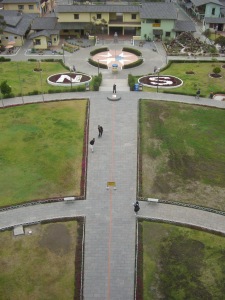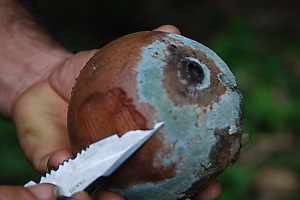I stood on the equator.
 Remember from primary school that imaginary line drawn around the world to split it into two hemispheres? Basically, anyone going into South America to Rio or Buenos Aires, or Santiago, crosses the equator every trip. So I’ve done it hundreds of times when I lived twenty years in Uruguay. But in Ecuador, it’s a big thing. They built a monument and museum to the equator that sits right on an orange line painted on the ground so you can actually see where it goes. I got the idea to visit the spot outside Quito when I saw Al Roker on the Today Show, who actually did some of the things I was planning to do in Ecuador – eat rare fruits, visit the Bellavista Rain Forest, and stand on the line with one leg in the northern hemisphere and one in the southern hemisphere – i.e., one leg in winter, one leg in summer. Really.
Remember from primary school that imaginary line drawn around the world to split it into two hemispheres? Basically, anyone going into South America to Rio or Buenos Aires, or Santiago, crosses the equator every trip. So I’ve done it hundreds of times when I lived twenty years in Uruguay. But in Ecuador, it’s a big thing. They built a monument and museum to the equator that sits right on an orange line painted on the ground so you can actually see where it goes. I got the idea to visit the spot outside Quito when I saw Al Roker on the Today Show, who actually did some of the things I was planning to do in Ecuador – eat rare fruits, visit the Bellavista Rain Forest, and stand on the line with one leg in the northern hemisphere and one in the southern hemisphere – i.e., one leg in winter, one leg in summer. Really.
 Here are some interesting facts about the equator moment:
Here are some interesting facts about the equator moment:
- The latitude is Zero Zero.
- At certain times of the year. March 21st and September 23rd you can stand on the line at noon when there is no shadow, then participate in the Equinoccial Dance.
- Here you can see rocks float on water.
- The moon sometimes shines brighter than the sun and you can take pictures in it without flash.
- On the equator, you travel at more than 1.667 kilometers per hour due to the rotation of the earth.
- This is the fattest part of the earth because you are farthest from the center of the earth.
But what drew me was the claim I’d weigh less here than anywhere else in the world. On the equator, everything weighs less as by Newton’s Gravity Law and there is a scale so you can test it out. However, after a healthy breakfast and tightening clothes, I didn’t want the reality. I just stood with one foot in each hemispheres and gloated. I didn’t feel any lighter.
At Arasha, a jungle-style, thatched roofed eco tourist “hot spot”, the guides were experts in fruits, birds, and tribal lore. Business was light at the beginning of the rainy season – walking from bedroom to the dining room inevitably meant passing through a light shower – so my guide took me on a special hike through a private organic orchard to learn about odd tropical fruits of Ecuador, like the delicious tree tomato so good for cholesterol which I drank as juice for breakfast each day. (There is so much more out there than orange juice. We have been conditioned to OJ. Why don’t you make strawberry juice fresh each morning? )
Cherimoya or custard apple I had already met in Atacama, but not Rosado, a sort of fruit gazpacho made from yucca, strawberries, pineapple and cherimoya chunks. I’ve long believed the plants and trees of our earth have all the secrets of healing so we should never have to use chemicals for our medicines. This very short stroll only proved my feelings aren’t crazy.
Take borojo, a brown round fruit that when skin is pealed reveals a brown paste like peanut butter. It’s served as juice or as a puree and is excellent for cholesterol problems as are the leaves of the fruitipan. Limes are extra bitter here and there is a mandarin-lemon fruit along with naranjilla, and every size of papaya, mango and pineapple. We took a cut out of a cinnabar or cinnamon tree to smell the curative spice, and then I was introduced to the “sangre del drago” (dragon blood) tree. It has a white tree bark that drips a red liquid when cut. Take a drop of the liquid and rub it continually on the back of your hand, as my guide did on mine. If it’s the real thing, it becomes a pink cream that heals.
 Achoate is a hairy egg shaped dark green and red skinned fruit which when opened reveals bright orange-red seeds. Rub your finger on these and you’ll find the dye which has been used for centuries by the Tsachilas tribe to tint their hair. This is why they are called “Colorados.” Then there are the various “g” fruits: guava, guayaba, guarana, guaramana, guanabana (a reptile looking fruit with white juice), all of which are delicious. If you really know your fruits, passion fruits vary according to colors of their flowers – the red flowered passion fruit is called maracuya. The purple flowered is granadilla. Taxo names the peach flowered fruit. And that goes on and on.
Achoate is a hairy egg shaped dark green and red skinned fruit which when opened reveals bright orange-red seeds. Rub your finger on these and you’ll find the dye which has been used for centuries by the Tsachilas tribe to tint their hair. This is why they are called “Colorados.” Then there are the various “g” fruits: guava, guayaba, guarana, guaramana, guanabana (a reptile looking fruit with white juice), all of which are delicious. If you really know your fruits, passion fruits vary according to colors of their flowers – the red flowered passion fruit is called maracuya. The purple flowered is granadilla. Taxo names the peach flowered fruit. And that goes on and on.
And I was told I hadn’t tasted anything wild until I’d watch the making of helado de paila, made high in the Andes from glacier ice and a bronze bowl filled with fruit puree placed on a stump and a bed of hay. When beaten well it creates a delicious sorbet.
Another popular food is patacone – fried plantains, not at all sweet. They are served with most entrees in place of french fries. There are more types of bananas than you can imagine (three out of every ten bananas in the world come from Ecuador) but nothing tastes as delicious as Ecuadoran empanadas – they are made from a dough of either maize, or of flour or of yucca and filled with cheese or fish or meat. The newest nutritional fad is bamboo “brotes” or buds which are being harvested as salad food like hearts of palm. Besides that, there are 150 species of potatoes. And we think we are cool when we harvest purple potatoes. Listen, there is so much variety of growth in Ecuador, the saying is: “plant stones, harvest apples.”
Final word, if you go to Ecuador, you must eat the cerviche. There is nothing raw about it. The seafood is cooked in a tomato-onion broth that is absolutely delicious and served in deep bowls. There is even a vegetarian cerviche with no fish in it at all. Servings are enormous and are always paired with a bowl of popcorn and a bowl of fried corn kernals. It became my daily diet.



